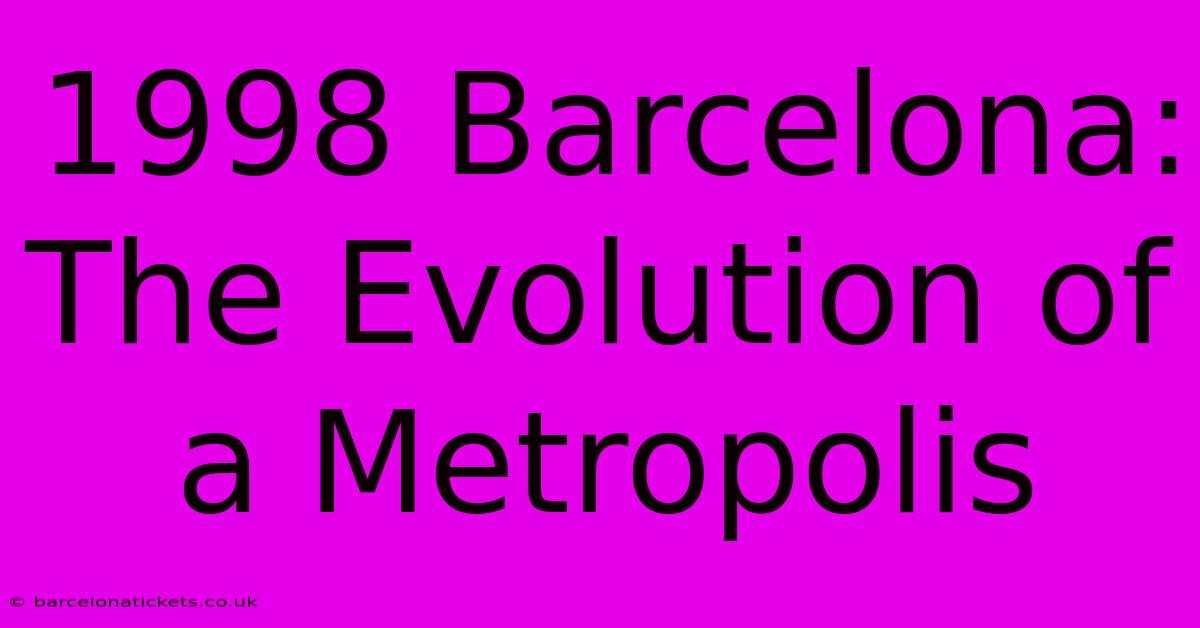1998 Barcelona: The Evolution Of A Metropolis

Table of Contents
1998 Barcelona: The Evolution of a Metropolis
Barcelona in 1998 stood at a fascinating crossroads. The city, already renowned for its architectural marvels like Gaudí's masterpieces and its vibrant culture, was undergoing a significant transformation, solidifying its place as a major European metropolis. This article explores the key elements that shaped Barcelona in 1998, examining its evolution across various sectors.
The Legacy of the 1992 Olympics
The 1992 Summer Olympics acted as a powerful catalyst for Barcelona's modernization. The significant infrastructure improvements undertaken for the Games – including revamped transportation networks, upgraded facilities, and a revitalized waterfront – left a lasting legacy. This period saw a dramatic improvement in the city's overall infrastructure, impacting everything from public transportation to urban planning.
Improved Public Transportation:
The Olympic Games spurred significant investment in Barcelona's public transport system. The modernization resulted in an efficient and extensive metro network, improved bus services, and the development of pedestrian-friendly zones in the city center. This made the city more accessible and attractive to both residents and tourists.
Revitalized Waterfront:
The transformation of the Barceloneta beachfront into a vibrant public space, complete with promenades, parks, and recreational areas, was another major outcome of the Olympic preparations. This area, once largely industrial, became a symbol of Barcelona's renewed urban identity.
A Booming Tourism Industry
1998 saw Barcelona firmly established as a major tourist destination. The city's rich history, stunning architecture, beautiful beaches, and lively cultural scene attracted visitors from across the globe. This burgeoning tourism industry had a significant impact on the city's economy and its social fabric.
Growth of the Hospitality Sector:
The influx of tourists led to the expansion of the city's hospitality industry, with new hotels, restaurants, and other tourism-related businesses opening up to cater to the increasing demand. This created numerous jobs and further stimulated economic growth.
Cultural Impact of Tourism:
While tourism brought economic benefits, it also had a significant impact on Barcelona's culture. The city navigated the challenges of managing tourism's growth, striving to preserve its authentic character while meeting the needs of a growing number of visitors.
Urban Development and Modernization
Beyond the legacy of the Olympics, Barcelona continued to evolve as a modern metropolis in 1998. This involved ongoing urban development projects, focusing on improving living conditions, enhancing green spaces, and promoting sustainable urban planning.
Sustainable Urban Planning Initiatives:
Barcelona was already demonstrating a commitment to sustainable practices, implementing projects aimed at improving air quality, reducing traffic congestion, and promoting the use of public transportation. This reflected a growing awareness of environmental concerns and their impact on urban development.
New Residential Developments:
New residential areas were developed both within the city center and on its periphery, responding to growing population demands. This included a mix of social housing projects aimed at providing affordable accommodation and private developments that catered to the growing middle class.
The Cultural Scene Flourishes
Barcelona's reputation as a culturally vibrant city was firmly cemented in 1998. The city hosted numerous events, festivals, and exhibitions, showcasing its rich artistic heritage and contemporary creativity.
Artistic Expression and Innovation:
The city's vibrant art scene continued to attract artists and creatives from around the world. Numerous galleries, theaters, and music venues provided platforms for artistic expression and innovation.
Preservation of Historical Heritage:
Barcelona's cultural identity also rested on the preservation of its rich historical heritage. Efforts were made to protect and restore historical buildings and monuments, ensuring that these invaluable assets remained integral to the city's identity.
Conclusion: A City on the Rise
Barcelona in 1998 represented a dynamic and evolving metropolis. The city's success stemmed from its ability to leverage past achievements, like the 1992 Olympics, while simultaneously embracing innovation and addressing modern challenges like sustainable urban development and the growth of the tourism sector. This period laid the foundation for the continued growth and international prominence Barcelona enjoys today. The city’s forward-thinking approach to urban planning, combined with its rich cultural heritage and dynamic atmosphere, ensured its position as a leading European city at the close of the 20th century.

Thank you for visiting our website wich cover about 1998 Barcelona: The Evolution Of A Metropolis. We hope the information provided has been useful to you. Feel free to contact us if you have any questions or need further assistance. See you next time and dont miss to bookmark.
Featured Posts
-
Sculpt Your Ideal Face Neck And Face Lifting In Barcelona
Apr 04, 2025
-
Show Your Colors 2014 15 Barcelona Kit
Apr 04, 2025
-
Create Your Legend Custom Barcelona Jersey
Apr 04, 2025
-
Barcelona V Valladolid The Stats Dont Lie
Apr 04, 2025
-
Master Spanish Grammar In Barcelona
Apr 04, 2025
